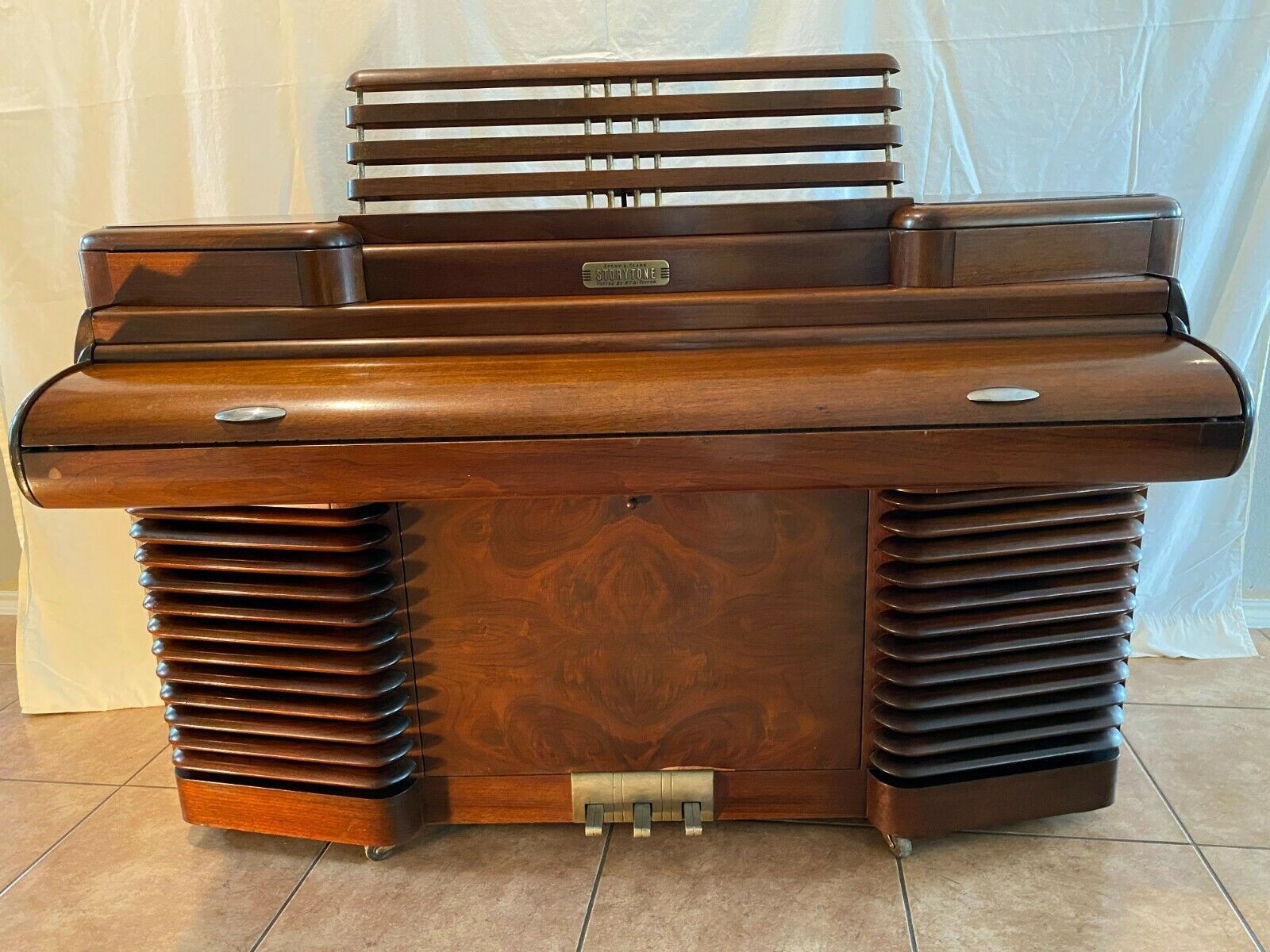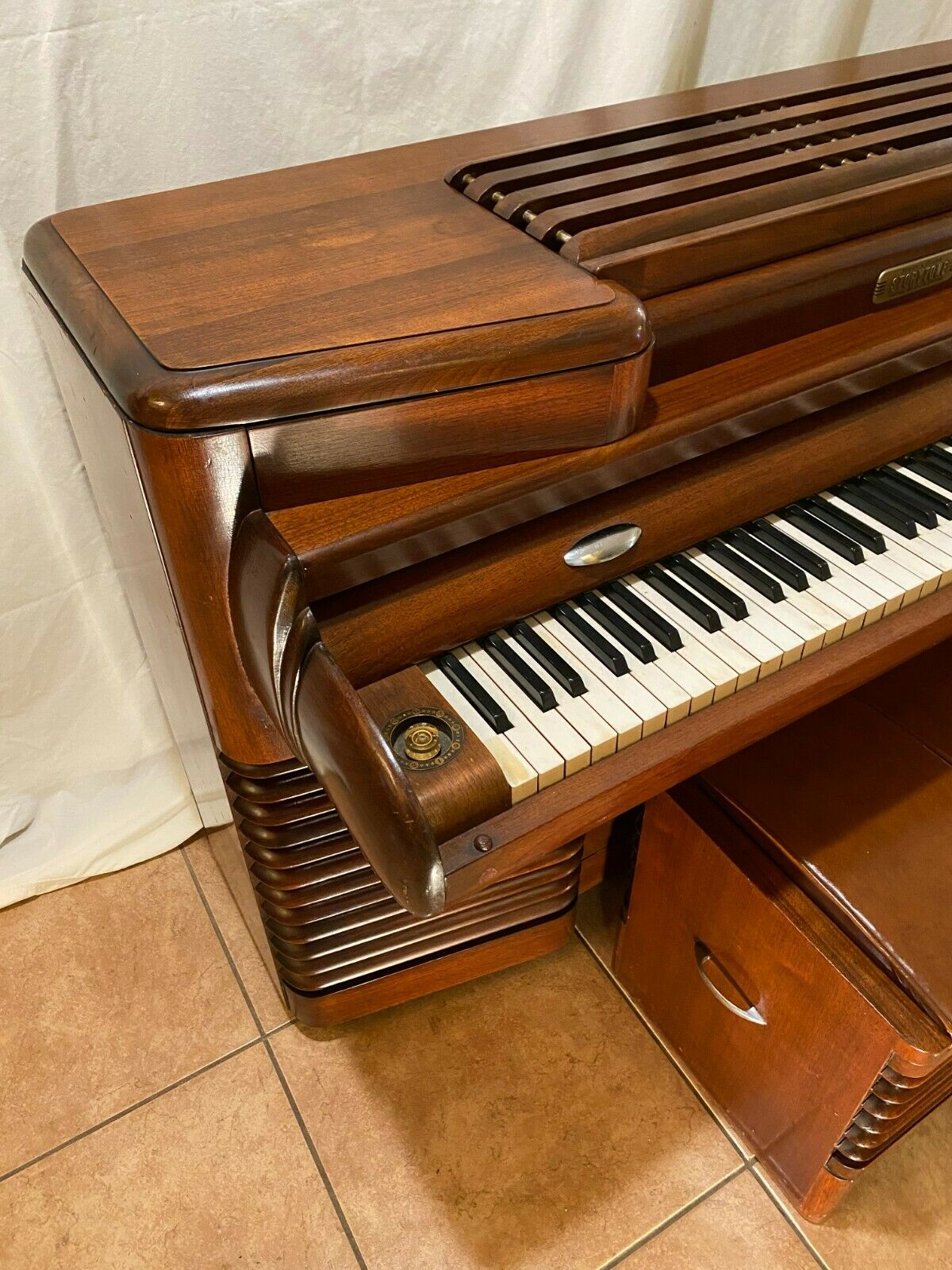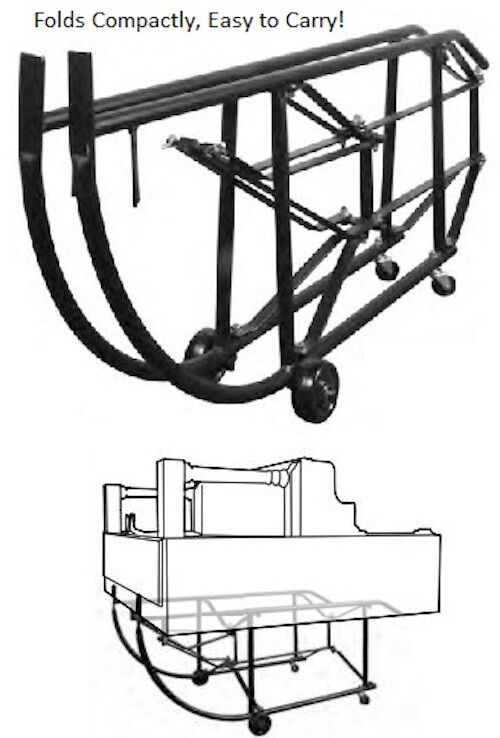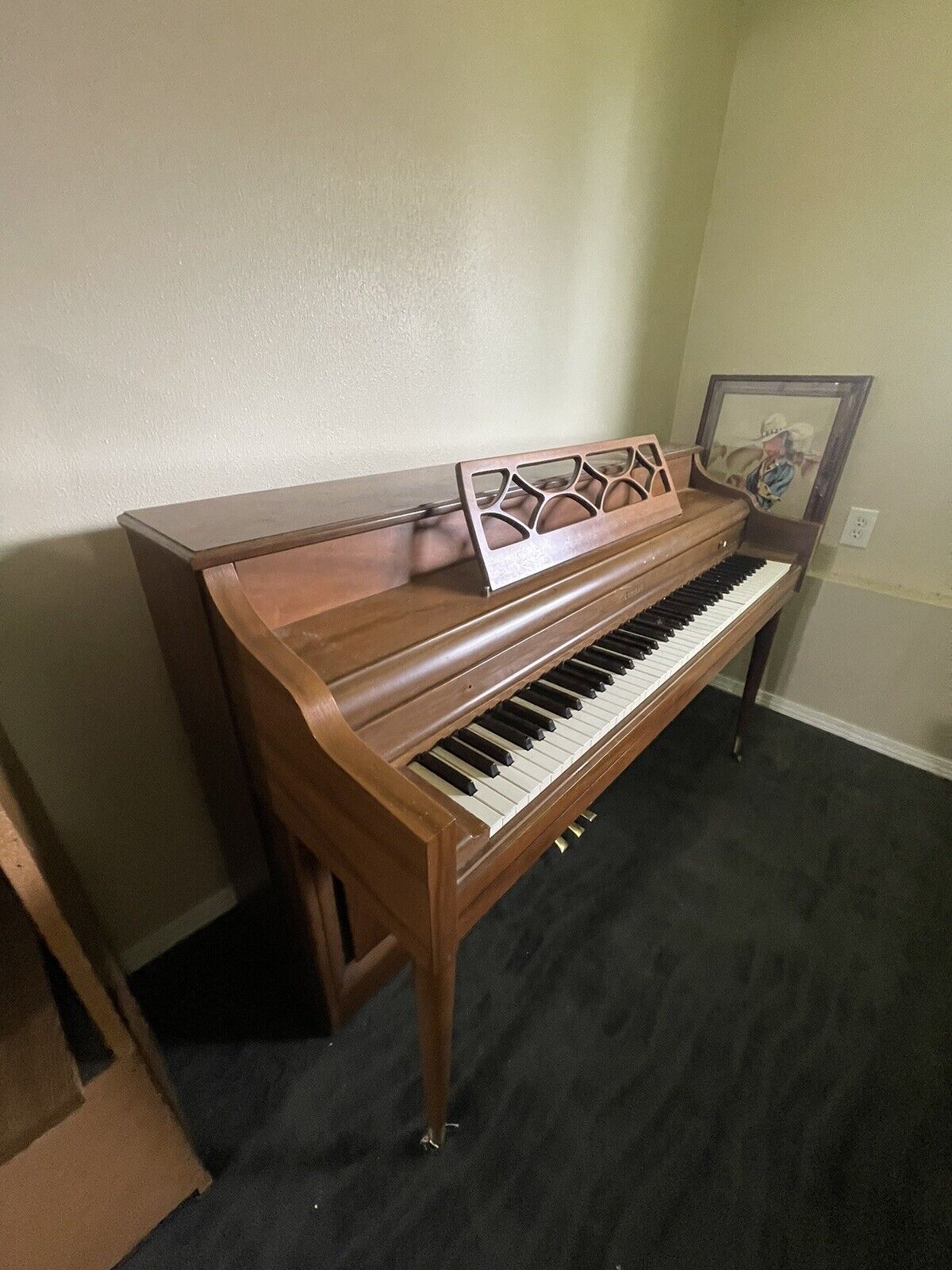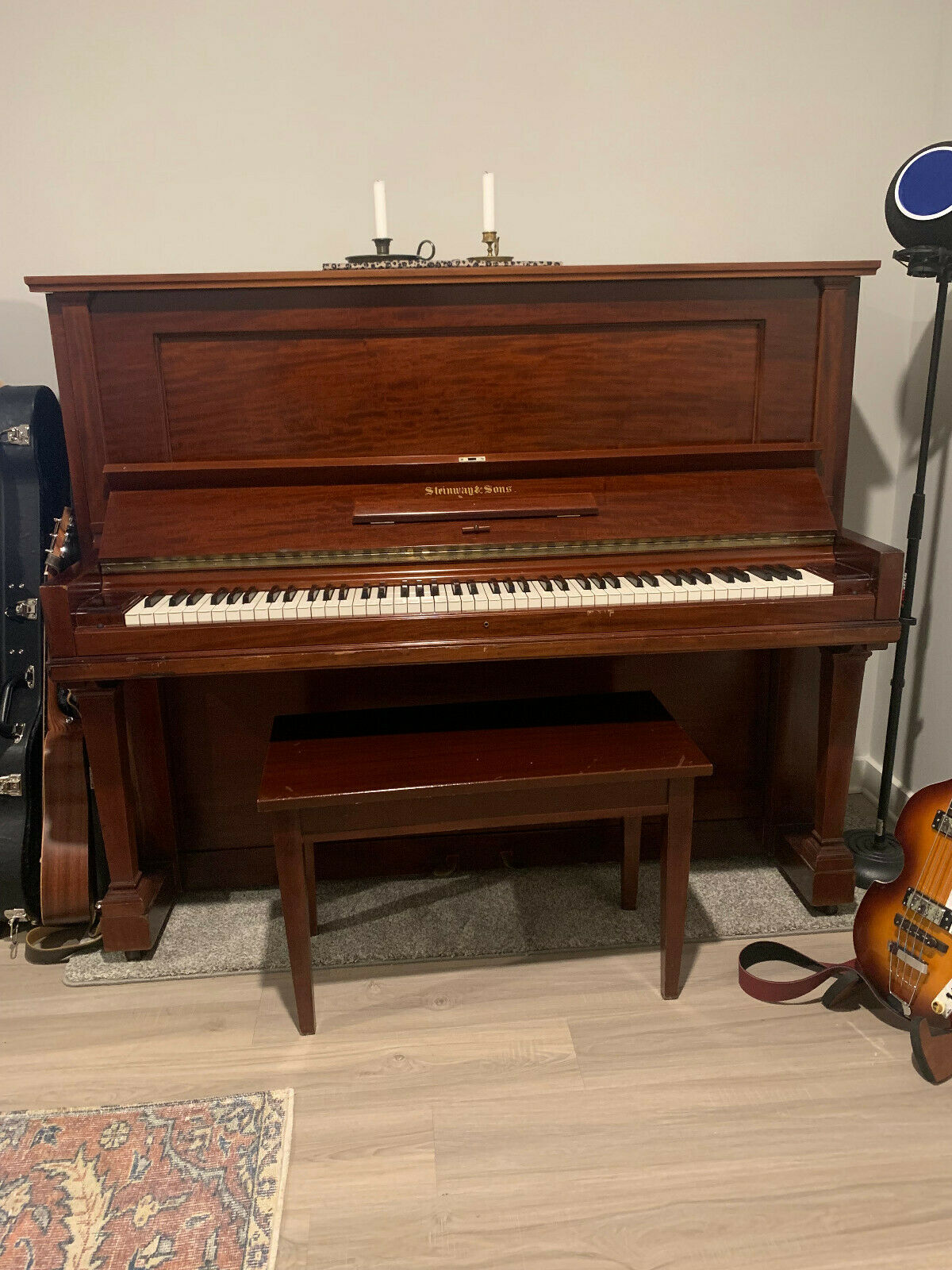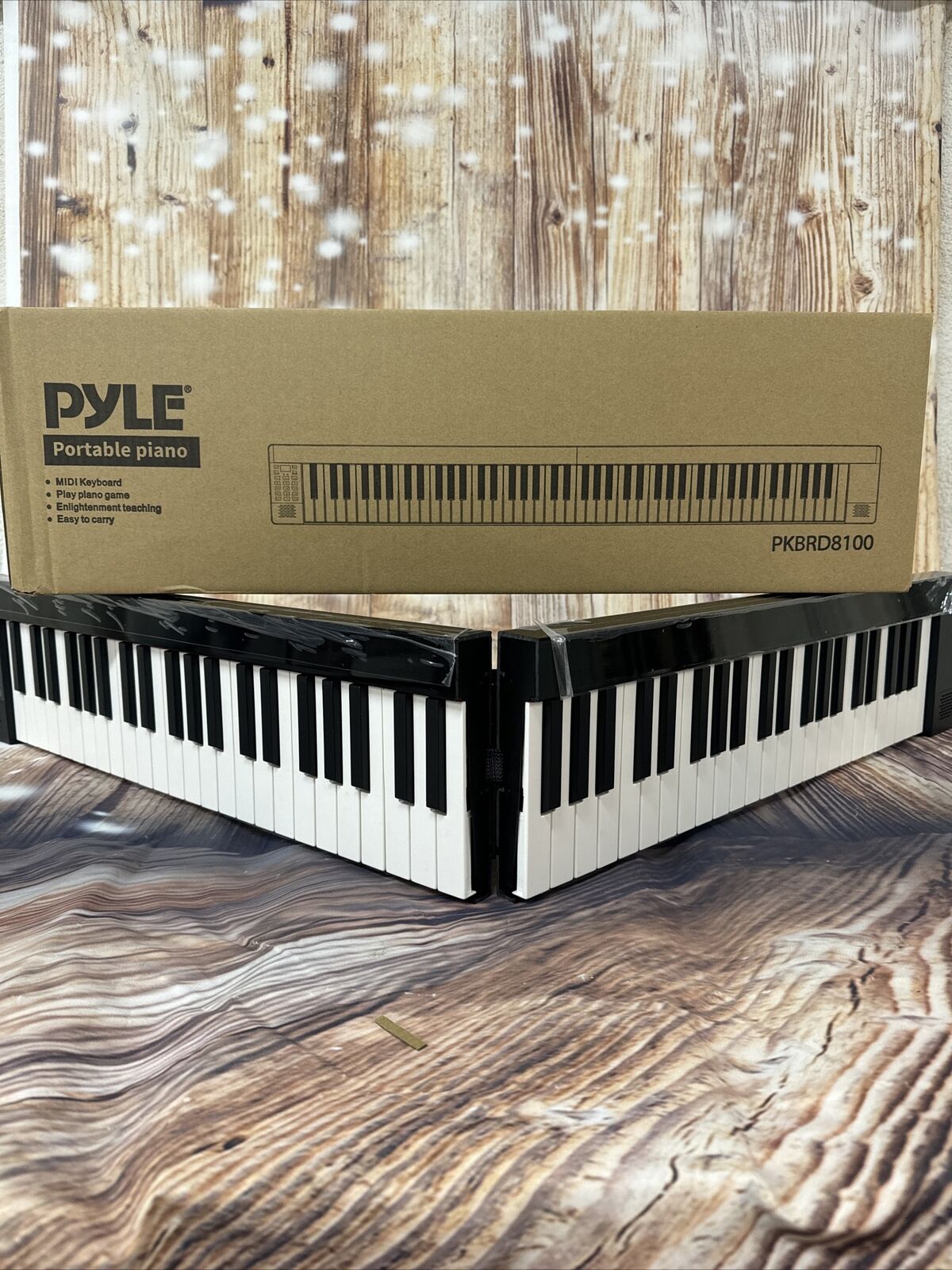-40%
1939 Storytone Worlds Fair Piano (RCA & Story and Clark) Piano Electric Vintage
$ 7656
- Description
- Size Guide
Description
1939 Storytone Worlds Fair Piano (RCA & Story and Clark) Piano Electric Vintage.Please ask any questions before purchase. We have additional pictures available for your inspection.
The RCA Storytone piano was built in 1939 in a joint venture between Story & Clark and RCA. This is an extremely rare and historically important instrument.
The first American electric piano, it debuted at the 1939 World's Fair.
It has an art deco/streamline design that rivals that of the finest furniture of the era. The case was designed by John Vassos, the famous and prolific American industrial designer of Art Deco Style. The design is striking – Art Deco expressed in one its most developed forms.
This piano is one of only approx. 150 made and comes with its original bench containing a radio and record player. The piano has normal strings and action but no soundboard.
The sound is amplified through
electromagnetic pickups, circuitry and a speaker system, making it the world's first commercial electric piano.
It was originally described as a 3-in-1 – Electronic piano “Voiced by RCA Victor” contains 7-tube, 20-watt amplifier operated by magnetic pickups adjacent to strings set in motion by striking hammers. Volume Control, “swell”, “damper”, and “soft” pedals provided. Bench contains radio tuner, phonograph (record player), to be plugged into main amplifier.
Earl "Fatha" Hines was one of the Jazz pioneers of America, developing Chicago Jazz, and a contemporary of Louis Armstrong.
He recorded Child of a Disordered Brain; Body and Soul in 1940. This recording was made on a 1939 Storytone RCA / Story & Clark Piano. The sound is very beautiful considering its design during the infancy of amplified instruments.
It works especially well for sustained styles of playing, as notes can last up to a minute or more with its unique form of resonance.
Dimensions: 59" w 28" d x 38" h
Bench: 32" w x 14" d x 19" h
All original electrical components work but need to be inspected by an electrician prior to or after shipping to verify all functionality.
Additional photos are available upon request
Please note that the shipping cost to the buyer will vary based on the buyer's location.
Additional Information F
rom Radio-Craft 1940-Feb pages 469-491
1939 Storytone Piano
Newest Electronic Piano
Radio reception and electric phonograph operation too are available, in a special piano-bench the use of which is optional, in the new “Storytone” electronic musical instrument (”Voiced by RCA”) here described.
Unlike preceding electronic pianos the new instrument utilizes magnetic pick-up from the strings; and a special acoustical system.
More business for aggressive radio dealers and Servicemen.
In addition to operating as an electronic piano (employing the general principles described in past issues of *Radio-Craft – except for certain differences as, for example, the use of magnetic instead of capacitive pickup heads), the new “Storytone” instrument here illustrated and described operates as a radio set, or as a phonograph, if the available special piano-bench (illustrated) is used.
This bench contains an RCA Victor radio set and phonograph, which makes it convenient for the pianist to accompany on the piano any record he may wish to play on the electric phonograph.
Technical Features
The Storytone piano (”Voiced by RCA”) incorporates a 7-tube amplifier with an output of 15.8 watts.
The loudspeaker is mounted in an acoustical labyrinth which covers the entire back of the piano.
High frequencies are radiated directly from the speaker baffle; low frequencies, from the labyrinth.
As with most electronic pianos a swell-pedal makes an organ characteristic possible.
The piano may be played, even by a child, at auditorium volume; or, at barely audible volume as a practice piano!
This dynamic range is quite impossible to obtain in non-electronic or mechanical pianos.
A special control permits adjusting the instrument to suit individual room acoustics!
The action of the piano is identical with a standard instrument so that the touch of the pianist remains the same.
Since the instrument is susceptible to stray magnetic fields, it should not be placed near other electrical equipment containing power transformers or rotating equipment such as motors or generators.
This is particularly true in theatre installations.
The electro-acoustic system consists of 3 major items.
First, a magnetic pickup translates the mechanical vibrations of each string into electrical impulses. Second, a high-fidelity electrical amplifier capable of reproducing the full audio range has an output of 15.8 watts (2% R.M.A. harmonic distortion). Thirdly, an acoustic transducer system consists of a ruggedly constructed permanent dynamic loudspeaker and a folded exponential baffle or horn capable of reproducing with remarkable fidelity and power the tonal qualities required of the fine instrument of which it is a part.
Magnetic Pickups
In order to translate the mechanical vibrations of the strings into electrical vibrations or impulses so that they may be amplified, individual magnetic pickups are used for each note.
These individual units are assembled on 8 separate mounting plates accommodating either 8, 10, or 16 units depending upon their particular location in the instrument.
Each pickup plate assembly consists of a soft steel mounting plate and 8, 10, or 16 magnets with a duplicate number of soft pole pieces.
A coil assembly is located over each individual pole piece and they are all connected in series and wired to a terminal board.
These 8 pickup plate assemblies are rigidly mounted at a fixed distance, adjacent to their respective strings.
Should feedback occur on any note, the serviceman should check the phasing of the pickup units; or finally, try reversing the voice coil leads.
Voicing
For simplicity of construction and ease of assembly and service the pickup units are rigidly mounted in sections, as previously discussed, at definite spacing from their individual strings.
Therefore, it is necessary to “voice” or equalize the output of the individual strings.
This is done before the piano leaves the factory.
But should it become necessary to replace a pickup unit in service the following procedure is given.
Voicing is accomplished by the following method which consists of individually magnetizing the strings corresponding to each note to an appropriate degree and polarity adjacent to the pickup, thereby either increasing or decreasing the pickup volume.
Referring to Fig. 2 a single steel piano string is represented.
The steel used for such strings is very readily magnetizable.
This string shown at A, passes over the usual bridge B, and has one end attached to the hitch pin C, in the pin rail D, the other end provided with appropriate tensioning means.
Underneath the string is shown a magnetic pickup consisting of a coil E wound on the soft iron core and the permanent magnet F located on mounting plate G.
The permanent magnet F induces magnetism n the core of coil E forming poles as indicated.
When string A is sounded, a voltage is generated in pickup coil E.
The string A can be magnetized longitudinally by placing a bar magnet H having poles, S and N as indicated, spaced approximately the same distance as the spacing of the pickup coil E and the permanent magnet F, and moved along and substantially in contact with the string.
The effectiveness of this magnetization on the pickup volume depends on how closely the poles of the magnet H approach those of the pickup unit.
In other words, when the degree of magnetization in the string adjacent to the poles of the pickup is increased, as would be the case with the poles of the bar magnet H as shown, the current through the pickup coil will be materially increased for a given amplitude of vibration of the string.
If the poles of the magnet H are reversed in position relative to the poles on the pickup unit and the string is thus magnetized then the amplitude of the current in the pickup coil will be decreased.
By following the above procedure the output from the weak notes may be increased and the output from the strong notes may be decreased producing the desired output over the entire scale for uniform force applied to each key.
In order to equalize the output of the various notes it is not necessary to use an output meter across a resistance load in place of the voice coil, for the use of the human ear is entirely satisfactory since it is in end, the final criterion.
In order to check for grounds or opens in the pickup units, should a lack of volume be apparent while voicing, open pickup leads to amplifier, and between various pickup sections in turn, to localize the trouble.
Amplifier
The A. F. amplifier consists of 2 major units.
One is amplifier proper, consisting of a 6J7 input stage, 6C5 driver, and four 2A3 output tubes in push-pull parallel; the other unit is the well-filtered power supply, using one 5Z3 tube as a rectifier.
The amplifier has 3 volume controls, one of which (R, in Fig. 1) is an integral part of the amplifier assembly.
It is the optimum volume control, a screwdriver adjustment, and should be set at the desired level upon installation.
It controls the maximum power output for the particular application and once set should require no adjustment.
Its electrical function is to limit the amount of voltage applied to the grid of the input tube, which voltage has been induced in the pickup devices, thus controlling the maximum output of the amplifier.
The other 2 volume controls are not integral with the amplifier but instead are located for convenient operation by the artist.
One, a manual volume control located at the left of the keyboard, is set for the desired volume output for the particular rendition.
The other is a pedal volume control, operated by the left foot, its magnitude of control dependent upon the setting of the manual volume control at the left of the keyboard.
The pedal control serves only to increase the volume from the level set by the manual control to a maximum limited by the setting of the screwdriver control on the amplifier chassis.
The amplifier is provided with a tone control for operation in connection with external inputs and functions when such inputs are connected to the phonograph jack on the amplifier chassis.
Hum
Should hum occur which cannot be corrected by regular means in the amplifier or power supply, short-out the pickup coils at the input of the amplifier.
If the hum disappears, then it is due to a stray magnetic field.
Check carefully the phasing of the pickup sections.
If phasing is in accordance with wiring diagram, check to see that the power supply shield is properly placed and grounded.
Check all ground connections and bonding of units between themselves and the frame of the piano.
Hum may be introduced by stray magnetic fields outside the instrument such as power transformers or electrical rotating machinery (motors or generators).
The socket voltages given on the schematic diagram are obtained at 115 V. on the 120 V. tap using a 20,000 ohms/volt meter (nearest scale D.C., and 1,000 ohms/volt A.C.)
Use with Auxillary Equipment
Should it be desired to connect the output of this instrument into an auxiliary amplifying system the method shown in Figure 3 should be employed.
This consists of taking a small portion of the output voltage from across the voice coil, that obtained across resistor R2, and applying it to the phonograph input of a radio receiver or P.A. amplifier.
